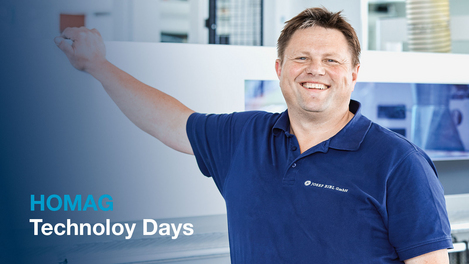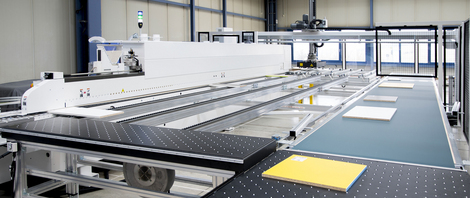25 Years of HOMAG Window Production Solutions - Concepts for automated production since 1999
HOMAG is the pioneer of automated window production solutions with CNC technology and has demonstrably left its mark here since the 1990s. The trigger for binging these solutions to the market was the requirement at that time to be able to handle the diversity in window construction without time-consuming manual tool changes.
Windows and glass doors form a dividing line from the outside to the inside of a building. They perform a range of functions which, in addition to ventilation and passage, can be summarized as heat, cold, weather, sound and burglary protection, as well as interior lighting. The aim was to reduce further work steps, such as rebating, attaching fittings using templates or drilling handle foils. The aim was to complete all processing steps on one machine at one workshop location.
Gradually, the perception and acceptance has shifted in such a way that complete processing of window parts with CNC technology is more economical, especially when the number of variants increases. Added to this is the trend for the machine to run as autonomously as possible, i.e. without personnel. Right from the start, HOMAG was able to implement complete table loading with up to half an hour of autonomous production. This was made possible by an integrated HOMAG software module for interfacing with the customer's window construction software.
The beginnings - step by step
The first HOMAG machine for the production of individual window parts, in this case in particular for wood-aluminum windows, was a profiLine BOF 311/40/PM. A machine length of 4.80 m provided the basis for clamping several pairs together. It could already boast a very high degree of automation. Automated individual console positioning, the ceiling laser for dynamically correct alignment of the workpieces and an 18-position tool changer for high flexibility in tool selection were available here. An initial connection to an office software program, KLAES, was also implemented.
In addition, many applications were automated as part of the production process, such as profile machining, drilling for handle slide holes, corner and shear bearing drilling, dowel hole drilling or milling for strike plates and shears. This generated high machine efficiency thanks to automated complete machining. Non-productive time for this machining could be used by the operator for other value-adding activities. The profiLine BOF 311/40/PM in 1999 was therefore the first complete CNC window production center. The first powerProfiler was installed in 2008. The machine celebrated its premiere at HOLZ-HANDWERK 2008 - and even there the CNC experts from HOMAG described the all-rounder as a machine that is "fit for the future and flexible in everyday use" and has window production "under control" with the new clamping technology.
A look at the present day - the customer has a choice
Even today, the CENTATEQ P-310 or P-510 series, with various clamping systems (semi-automatic/automatic), is still used for manual production steps in smaller companies/mixed operations, depending on requirements. Automatic solutions are served by the 3rd generation powerProfiler BMB 800/900 (now CENTATEQ S-800 and CENTATEQ S-900), which has been on the market since 2014. New clamping technology for narrow profiles, the large "Tooltower" tool storage system and scalable performance are just some of the new features that have been added. Depending on the equipment, we can offer everything from a single-engine machine to a 5-engine machine for every customer and every requirement.
In order to achieve the desired performance, it is essential to clarify and discuss the product range in detail with the customer in advance. All parties involved in the project, such as tool manufacturers or industry software providers, must be involved. The performance-influencing variables such as tool layout or the new type of corner joints must be worked up and then set out in detailed drawings and processing sequences. If larger window lots are required per production shift, HOMAG relies on redundancy, i.e. the sensible and flexible interlinking of several machines.
The result is a package of window profiles individually tailored to each customer in combination with the right performance for the respective operation. HOMAG machines are precisely tailored to the customer's needs, from the smallest performance class right up to maximum performance. For high performance requirements per shift, HOMAG relies on the combination of several machines to achieve redundancy. Bulky machines, as used to be the case with throughfeed systems, are a thing of the past due to the required flexibility and availability.
From the individual machine to the connected cell
HOMAG offers small and medium-sized window manufacturers the opportunity to continue producing windows individually with a lean core team and to satisfy their customers. The CENTATEQ S-800 with a scalable output of up to 40 window units is configured to suit every customer requirement. The CENTATEQ S-900 with up to 70 window units on one machine is available for larger output units.
The CENTATEQ S-900 with maximum equipment is a very powerful and flexible window machine. It has two processing tables and independent units on both gantry sides. The basis is formed by the processing tables and units of the CENTATEQ S-800 - but twice: this means that two completely different parts can be processed independently of each other at the same time. The machine also features double-spindle technology: A profile splitting unit with two milling spindles that can be adjusted in Y and Z in relation to each other via axes. This makes it possible to use two profile cutters simultaneously on one workpiece in one longitudinal milling pass.
This ensures that production is always maintained, which is not the case with less flexible, interlinked systems. By combining standardized individual systems, the system technology remains manageable and controllable! Of course, the systems can also be installed in combination. Starting with a pure console machine, with the powerProfiler CENTATEQ S-800 and / or with CENTATEQ S-900, depending on the requirements of the range of variants to be produced.
An increase in the machine's unmanned running time can be realized cost-effectively in the large or small solution by simply extending the workpiece buffer. In other cases, this can be achieved by automatic loading using rack trolleys or various types of interlinking. With such high-performance systems, the running time must be optimized, which is why, among other things, the service life of the tools must be preserved and the quality of the manufactured parts ensured. This is achieved via software features, from the master control to tool life monitoring. Tool cleaning systems integrated into the machine can also be used. The benefits of this depend largely on the types of wood to be processed.
Flexible control simplifies the mapping of corner joints
It is not only the window scantlings that are changing, but also the design of the corner joints. Based on the classic mortise and tenon joint are the new, so-called "mortised corner joints". PlugTec, Prüller corner, hybrid corner or even the Konnex corner are well-known and successfully used corner joints for window production. Almost all of these have been developed and tested on HOMAG machines, as HOMAG, with its flexible end-to-end control system, can map this most easily. Whether these are used completely on the entire window or only for sashes must be decided on a case-by-case basis.
The corner joints, which are complex to program, can be easily created using the woodWOP window software. Here, HOMAG has an absolute advantage with its in-house developed "window interface" for the communication of its machine to the industry software houses and therefore the right answer. It is easy to connect and does not require any other interfaces to the industry programs apart from the HOMAG window interface. Individual parts or special parts can be easily programmed and created by the customer himself on all HOMAG machines via woodWOP.
Digitalization and the tools it offers
Developments in the woodworking industry today are heavily influenced by megatrends such as automation and digitalization. This is particularly reflected in control and computer technology, which are key technologies that determine the expansion of the entire production process as well as individual processing methods. HOMAG recognized this early on like no other company and has continuously presented solutions. In 1985, for example, the company introduced a new type of control system under the name Homatic, followed by the development of a production line control system with which workpieces could be tracked across several machines working in a network. Since 2005, the successor, the "powerControl" control system, has dominated, which is accompanied by a decentralization of the control systems and control cabinets. At LIGNA 2013, HOMAG finally presented powerTouch, a touchscreen operating concept that combined design and function and, in combination with the powerControl control system, offered a high level of customer benefit. Standardized operating elements and software modules have ensured that all HOMAG machines can be operated in the same way ever since. The next generation - powerTouch2 - followed in 2019.
| Milestones at a glance | |
|---|---|
| 1999 | Presentation of the first machine BOF 311/40/PM with a specific clamping system for window scantlings |
| 2004 | The Flex5 unit for sawing, routing and drilling at any angle and the chain changer for quick tool changes are coming onto the market |
| 2008 | Introduction of the automatic table (MA table) for automatic reclamping and launch of the first automatic machining center BOF 700 – powerProfiler |
| 2011 | Presentation of the powerProfiler 2, the automated window system in a new design |
| 2014 | The new generation powerProfiler with extended functions such as the 3D clamping technology comes onto the market and the introduction of the "Tooltower" tool storage system ensures short changeover times |
| 2018 | Design change and a new product name make otf the powerProfiler the CENTATQ S-800/900 |








